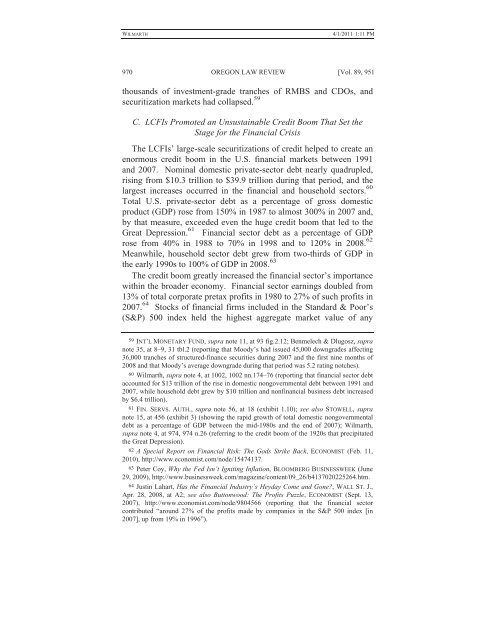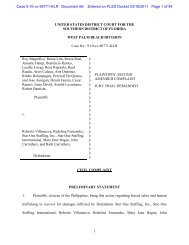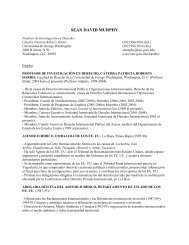CLE Materials for Panel #1 - George Washington University Law ...
CLE Materials for Panel #1 - George Washington University Law ...
CLE Materials for Panel #1 - George Washington University Law ...
Create successful ePaper yourself
Turn your PDF publications into a flip-book with our unique Google optimized e-Paper software.
WILMARTH<br />
4/1/2011 1:11 PM<br />
970 OREGON LAW REVIEW [Vol. 89, 951<br />
thousands of investment-grade tranches of RMBS and CDOs, and<br />
securitization markets had collapsed. 59<br />
C. LCFIs Promoted an Unsustainable Credit Boom That Set the<br />
Stage <strong>for</strong> the Financial Crisis<br />
The LCFIs’ large-scale securitizations of credit helped to create an<br />
enormous credit boom in the U.S. financial markets between 1991<br />
and 2007. Nominal domestic private-sector debt nearly quadrupled,<br />
rising from $10.3 trillion to $39.9 trillion during that period, and the<br />
largest increases occurred in the financial and household sectors. 60<br />
Total U.S. private-sector debt as a percentage of gross domestic<br />
product (GDP) rose from 150% in 1987 to almost 300% in 2007 and,<br />
by that measure, exceeded even the huge credit boom that led to the<br />
Great Depression. 61 Financial sector debt as a percentage of GDP<br />
rose from 40% in 1988 to 70% in 1998 and to 120% in 2008. 62<br />
Meanwhile, household sector debt grew from two-thirds of GDP in<br />
the early 1990s to 100% of GDP in 2008. 63<br />
The credit boom greatly increased the financial sector’s importance<br />
within the broader economy. Financial sector earnings doubled from<br />
13% of total corporate pretax profits in 1980 to 27% of such profits in<br />
2007. 64 Stocks of financial firms included in the Standard & Poor’s<br />
(S&P) 500 index held the highest aggregate market value of any<br />
59 INT’L MONETARY FUND, supra note 11, at 93 fig.2.12; Benmelech & Dlugosz, supra<br />
note 35, at 8–9, 31 tbl.2 (reporting that Moody’s had issued 45,000 downgrades affecting<br />
36,000 tranches of structured-finance securities during 2007 and the first nine months of<br />
2008 and that Moody’s average downgrade during that period was 5.2 rating notches).<br />
60 Wilmarth, supra note 4, at 1002, 1002 nn.174–76 (reporting that financial sector debt<br />
accounted <strong>for</strong> $13 trillion of the rise in domestic nongovernmental debt between 1991 and<br />
2007, while household debt grew by $10 trillion and nonfinancial business debt increased<br />
by $6.4 trillion).<br />
61 FIN. SERVS. AUTH., supra note 56, at 18 (exhibit 1.10); see also STOWELL, supra<br />
note 15, at 456 (exhibit 3) (showing the rapid growth of total domestic nongovernmental<br />
debt as a percentage of GDP between the mid-1980s and the end of 2007); Wilmarth,<br />
supra note 4, at 974, 974 n.26 (referring to the credit boom of the 1920s that precipitated<br />
the Great Depression).<br />
62 A Special Report on Financial Risk: The Gods Strike Back, ECONOMIST (Feb. 11,<br />
2010), http://www.economist.com/node/15474137.<br />
63 Peter Coy, Why the Fed Isn’t Igniting Inflation, BLOOMBERG BUSINESSWEEK (June<br />
29, 2009), http://www.businessweek.com/magazine/content/09_26/b4137020225264.htm.<br />
64 Justin Lahart, Has the Financial Industry’s Heyday Come and Gone?, WALL ST. J.,<br />
Apr. 28, 2008, at A2; see also Buttonwood: The Profits Puzzle, ECONOMIST (Sept. 13,<br />
2007), http://www.economist.com/node/9804566 (reporting that the financial sector<br />
contributed “around 27% of the profits made by companies in the S&P 500 index [in<br />
2007], up from 19% in 1996”).

















